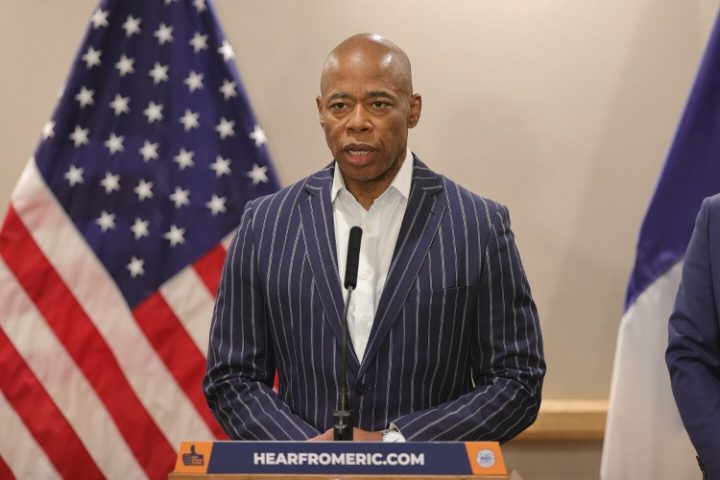
As New York’s migrant crisis worsens, city leaders have decided spending public money to cover the travel whims of illegal aliens is an investment compared to keeping those migrants living in the city on the taxpayer dime. Not only are they being flown to other states, but even to other countries, such as Morocco and Colombia.
Democratic Mayor Eric Adams is accelerating a program that involves giving migrants one-way flights to their destination of choice, a parallel to similar efforts in Republican states, where governors are busing, flying, or otherwise moving migrants out of their jurisdictions to avoid the enormous expenses associated with mass migration.
“When you are out of room, that means you’re out of room,” Adams said this week, as reported by Politico. “Every year, my relatives show up for Thanksgiving, and they want to all sleep at my house. There’s no more room. That’s where we are right now.”
The Adams administration now has a Manhattan office entirely dedicated to booking plane tickets for migrants, to which the mayor’s office is directing foreign nationals amid a shelter shortage provoked by the staggering traffic pouring into the Big Apple. Approximately 130,000 migrants have entered New York City since last year alone. About 4,000 are currently coming in each week.
“With no sign of a decompression strategy in the near future, we have established a reticketing center for migrants,” said City Hall spokeswoman Kayla Mamelak in a statement. “Here, the city will redouble efforts to purchase tickets for migrants to help them take the next steps in their journeys.”
Mamelak added that “nothing is off the table” in order to deal with the crisis — including distributing tents.
The mayor’s office has coupled the flights with limits on shelter stays — measures the city says are necessary to make space for new arrivals and reduce the number of people being cared for by the city. Officials believe the policies are working, pointing to statistics that say fewer than 20 percent of the migrants who received 30- and 60-day vacate notices have reapplied to return to city lodging.
Politico further noted of New York’s reticketing program and its woes in attempting to provide shelter to the thousands of migrants pouring in:
The city has used reticketing since the crisis began about 18 months ago, but it now has a dedicated site separate from the Roosevelt Hotel intake center in midtown Manhattan. Officials did not have immediate information on how much they’ve spent more recently on tickets or where the bulk of the travelers requested to go.
Adams told reporters this week that he’s talking with other countries about how they’ve managed migrants sleeping outdoors, a prospect that the Legal Aid Society and the Coalition for the Homeless stress runs contrary to the city’s right-to-shelter obligation to provide a bed for any one who needs it.
“We have to make sure that people have some type of restroom facilities, some type of shower network,” Adams told reporters Tuesday.
These policies have not been without their detractors.
Speaking to Politico, City Council member Shahana Hanif accused Adams’ policies of lacking compassion.
“What we’ve witnessed from this administration — even if they’re not directly saying ‘you’ve got to get out of here’ — is that they’ve consistently created hysteria and chaos and confusion and have not used a tone of inclusivity and welcome,” she said.
Additionally, Hanif argued that keeping track of a migrant’s asylum process and work authorization application is nearly impossible to do once he or she leaves the city.
And some asylum seekers, such as migrants from the West African nation of Mauritania, are rejecting the reticketing offer, saying they prefer to stay in New York and seek work in the city.
Adams defends his action by saying that his policies have thus far allowed the city to keep children off the streets.
The city’s network of shelters includes hotels, churches, and governmental buildings across five boroughs — a system Adams’ office says will cost $12 billion over three years.
And some Democratic lawmakers want to expand this system into the suburbs with subsidized-housing vouchers that would place migrants in permanent housing instead of temporary shelters.
Among these voices is city councilwoman Diana Ayala, who said in an interview, “I do really understand the complexity of what they’re being asked to do under the circumstances. But I don’t think that their policies are helpful. I think they have the potential to leave thousands of individuals out on the street.”
However, New York Governor Kathy Hochul has refused to grant New York City Mayor Eric Adams’ request to use the suburbs as a relief valve for the excess of migrants in the city — putting the two Democrats at odds with one another. And even if Hochul does give in, local leaders in those suburban communities have already vowed to resist the move in court.
Thus, unless the border is closed and the flow of migrants stopped, New York City is akin to a ticking time bomb that will inevitably burst.




